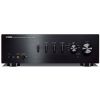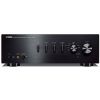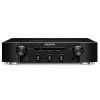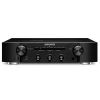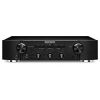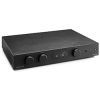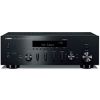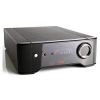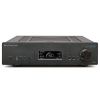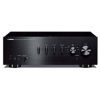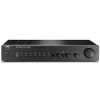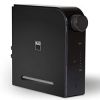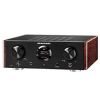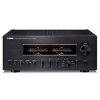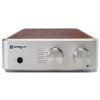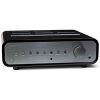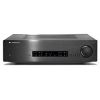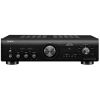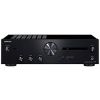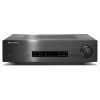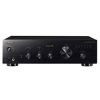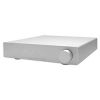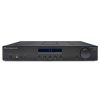| Overall | Amplifier | Audio features | Control | Extensive connection | |||
|---|---|---|---|---|---|---|---|
| Yamaha A-S801 | 9.5 | 10 | 9 | 10 | 9 | See price | 25 |
| Yamaha R-N602 | 9.5 | 9 | 8 | 10 | 9 | See price | 30 |
| Yamaha A-S501 | 8.7 | 9 | 7 | 10 | 9 | See price | 23 |
| Marantz PM6007 | 8.5 | 8 | 7 | 10 | 9 | See price | 35 |
| Yamaha A-S301 | 8.2 | 8 | 7 | 10 | 8 | See price | 1 |
| Yamaha A-S1100 | 8 | 9 | 7 | 10 | 6 | See price | 4 |
| Marantz PM8006 | 8 | 9 | 7 | 10 | 6 | See price | 21 |
| Yamaha A-S3000 | 8 | 8 | 7 | 10 | 7 | See price | 3 |
| Cambridge Audio Azur 851A | 8 | 9 | 8 | 8 | 7 | See price | 8 |
| Marantz PM6006 | 7.7 | 7 | 7 | 10 | 7 | See price | 20 |
Integrated amplifiers are devices for music lovers. It is an amplifier, all the functional blocks of which are located in one housing, including all controls, the preamplifier part, and the power amplifier.
It is an extremely important component of the stereo system, which is responsible for amplifying the signals coming from sources connected to the amplifier, switching connected sources, adjusting the volume, and transmitting the amplified signal to the speaker systems for its reproduction.
Given this, the real music lover is obligated to have the best integrated amplifier. And in order for you to easily come up with the right decision of which amp to choose, we divided presented goods by price or characteristics (tube). Let’s go and find your integrated amplifier for turntable.
Best integrated amplifier reviews
Integrated amplifiers under 500
Devices of this price category are known for their ability to suit beginner’s needs. Also, they are intended for those people who don’t demand great specifications for a stereo integrated amplifier.
Yamaha A-S301 - best under 500

The developers claim that when designing the A-S301, all the company's experience in creating not only amplifiers but also musical instruments was used.
The built-in DAC allows you to receive digital audio from a DVD / BD player, satellite receiver or TV, and if you connect the optional YBA11 Bluetooth adapter to the amplifier (via the coaxial bus, the adapter has an appropriate output), you will be able to play files stored on your smartphone. AptX codec is supported, so the loss of wireless signal transmission will be minimal. Like the CD-N301 player, the amplifier is equipped with an Auto Power Standby function: for more than 8 hours, the device will not be idle, it will go into standby mode. 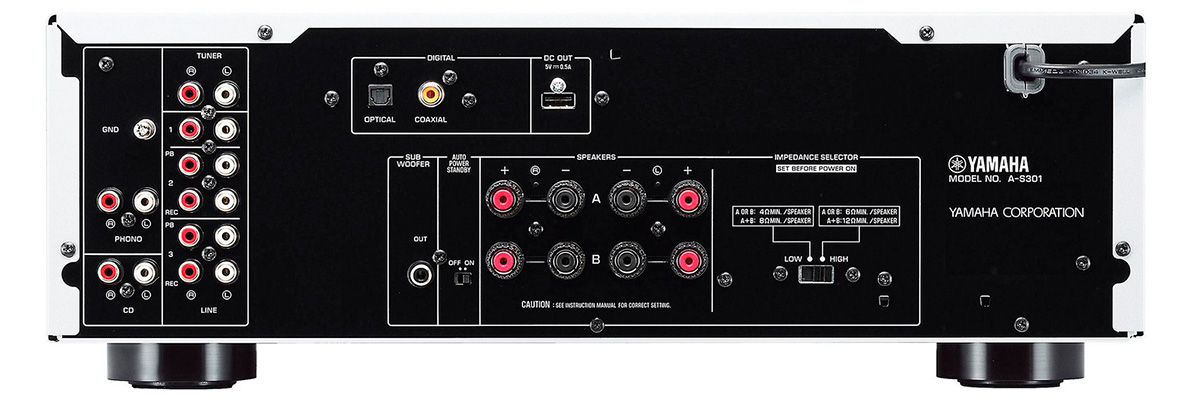
Round knobs of large and small diameters are responsible for changing the volume and selection of inputs. The tone, balance, and volume controls, respectively, are equipped with handles in the form of truncated cones. There is also a rotary switch for working with one / two sets of speakers or only with headphones, the 6.3-mm output to which is located nearby. You must admit that you can’t call such a design a classic of the genre. But the equipment of the rear panel is much more than a simple tribute to traditions. In addition to five line inputs (two with a through the channel) and the Phono-corrector input for an MM cartridge, a subwoofer output, as well as coaxial and optical digital audio inputs are provided. There is also a USB B socket, which plays the role of a 5 V power supply for Yamaha branded accessories, such as the YBA-11 Bluetooth adapter. The sound output power is 60W (8 ohms).
It is noteworthy that there are two pairs of acoustic terminals, which allows you to organize the operation of the speakers according to the bi-wiring scheme, and a switch that ensures that the output impedance of the amplifier path matches the impedance of the connected speakers. In short, it is felt that the developers paid special attention to the quality of the construction of this tract.
Key specs
- Power output (RMS), W/Ohm: 120/8, 140/6
- Line level inputs (pair): 8
- Phono (MM) input: yes
- Subwoofer output: yes
- Official website
- Full specs
Pros
- The device will not be idle for more than 8 hours. It will go into standby mode
- It is possible to turn off the tone, balance and loudness controls (Pure Direct mode)
Cons
- The built-in DAC was a little disappointing: with a high-frequency response it produces a signal with a rather high THD
Onkyo A-9110
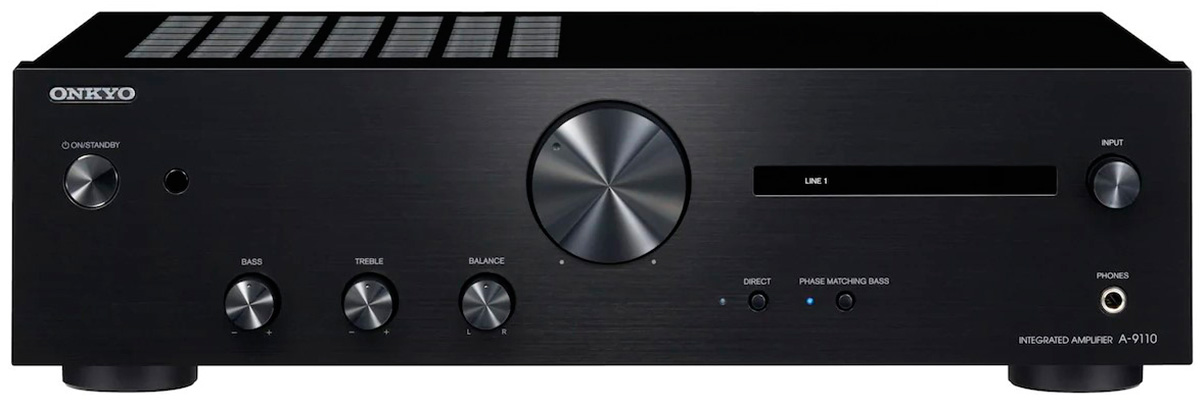
Looking at the Onkyo A-9110 integrated amplifier, the glorious 90s immediately pop up in my memory when we were looking forward to the annual catalogs of large brands' products, and each manufacturer had a whole fleet of devices, starting from entry-level models and ending with High-End. It looks like Onkyo decided to return to this forgotten philosophy and offered customers an attractive entry-level model A-9110, which is ideal for beginners in the world of Hi-Fi.
In the center of the neat front panel is a large rotary knob for volume control. Next to it is a small screen input selector, as well as Bass / Treble / Balance controls. In addition, there is an activation button for the Phase Matching Bass function, which boosts bass and treble levels at low volume levels. And our favorite feature is the Direct mode, in which the signal is bypassed by the timbral block, which avoids the occurrence of unwanted interference. The amplifier is also equipped with a built-in headphone amplifier, for the connection of which there is a 6.3 mm jack on the front panel. In general, the build quality and appearance of the Onkyo A-9110 are so good that the amplifier looks more expensive than it actually is.
A-9110 has a rigid metal chassis, which is 1.3 times thicker than its predecessor A-9010, which, combined with massive, widely spaced supports, can almost completely eliminate unwanted resonance. It has five analog inputs, including an MM phono stage circuitry and one analog output, high-quality gold-plated terminals for connecting speakers, compatible with banana plugs. 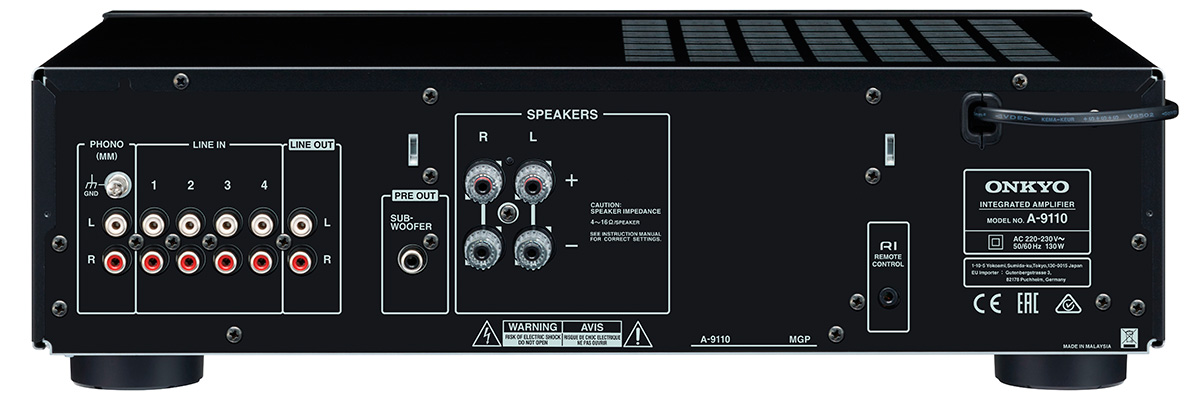
With a little creativity, you can build a modest, but high-quality audio system around the Onkyo A-9110. For example, the inexpensive Rega P1 or Pro-Ject Debut vinyl player will give you the pleasure of analog recordings, while the network player allows you to enjoy digital content from a NAS / PC or Internet radio and network services.
Onkyo A-9110 proved to be an absolutely harmonious performer, although I missed some small details, this is quite normal, given the modest cost of the amplifier. In general, Onkyo A-9110 demonstrates a clear and focused playing style that gives the music a dynamic start without excessive rigidity or even rudeness. It provides 30W at 8 ohms of power. The amplifier sounded really "grown-up" and surprised with pleasant straightforwardness.
Onkyo A-9110 has a very good combination of price and quality and great sound. By connecting suitable speakers and a network player and/or vinyl player, you get a good home audio system. By far, it is the best integrated amplifier under 500.
Key specs
- Power output (RMS), W/Ohm: 60/8, 100/4
- Line level inputs (pair): 5
- Phono (MM) input: yes
- Subwoofer output: yes
- Official website
- Full specs
Pros
- Onkyo A-9110 delivers dynamic, accurate and clear feeding
- Jack for connecting headphones is another opportunity that is not too common in budget technology
Cons
- Fixed power cord
Integrated amplifiers under 1000
Here we have the next stage of devices. Amplifiers from this price range have an optimal combination of price/quality. These goods can’t be called a beginner’s level but, at the same time, require some characteristics to be higher priced.
Yamaha A-S801 - best under 1000
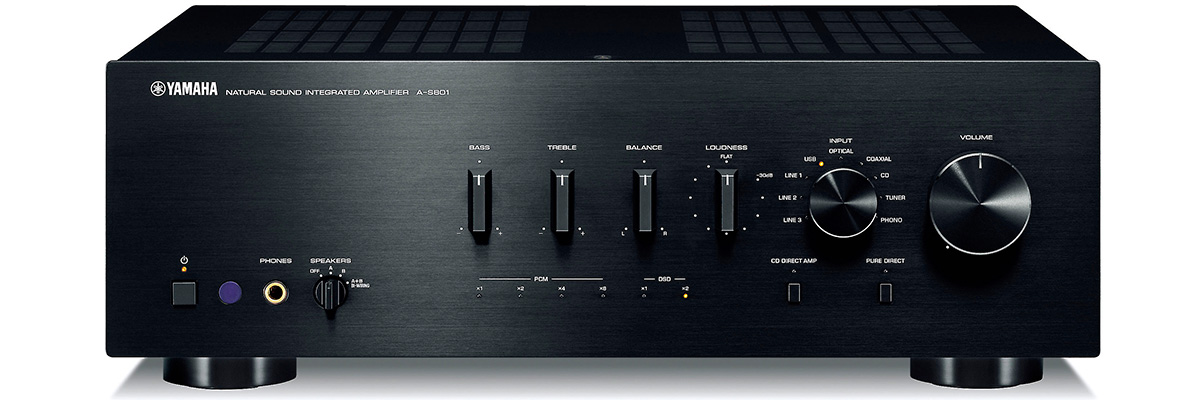
To start after reviewing a bunch of devices under 1000, I can call this unit the best integrated amplifier under 1000. Why? Let’s see.
This unit boasts 100W at 8 Ohms. The amplifier is equipped with digital audio inputs of optical and coaxial types. The optical jack is for receiving audio from a TV, and the coaxial is for a Blu-ray disc player. The signal remains in the digital domain, and this provides clear, pristine, dynamic sound from any source: from sports and other programs to movies and concerts.
With the YBA-11 adapter, you can wirelessly stream music from a Bluetooth-enabled mobile phone, tablet, or PC using the network audio signal receiver built into the amplifier. With digital connectivity and aptX audio coding, optimum sound quality is ensured. To simplify the power supply of the adapter, it is provided for its connection to the DC output on the rear panel of the amplifier.
You can connect two separate sets of speakers installed in different rooms and either switch them or turn them on simultaneously. Four terminals are provided for connection, and you can switch between two pairs of terminals to select the desired sound source.
A subwoofer connector is provided to enhance the low-frequency component of the audio system to make the overall sound more powerful and high-quality. 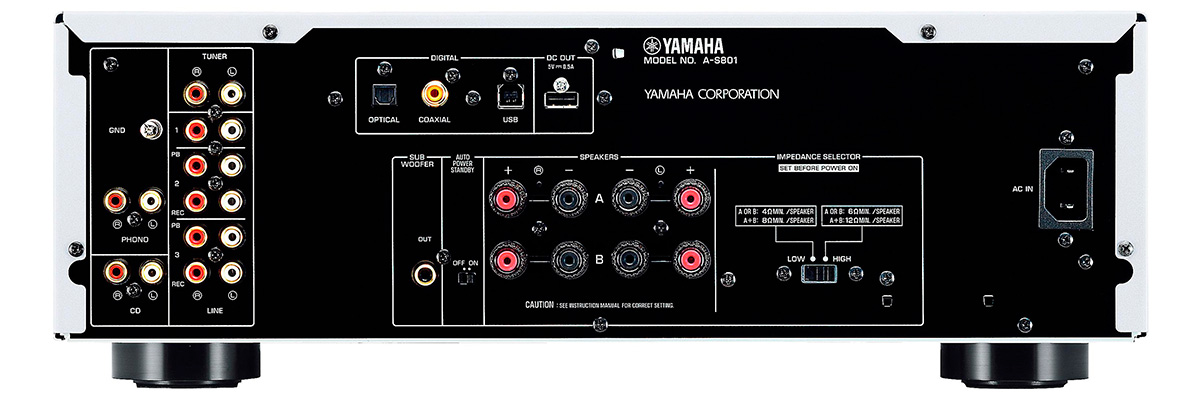
You can connect a turntable with an MM type pickup head (with the moving magnet). This will allow you to use the amplifier with its latest technical capabilities to listen not only to CDs but also to analog recordings.
Thanks to the unique - simple and at the same time aesthetic - design, directly inherited from other high-end Yamaha audio components, the Yamaha A-S801 amplifier, like its predecessors, has an intuitive layout of buttons and knobs. The aluminum front panel has an elegantly textured finish in the form of thin “hair” lines. No less presentable controls are identical to those used on our "top" models.
The simple and clear design of the remote control allows you to perform all the necessary operations with one hand (for example, adjust the volume or set the playback order of tracks). The remote control, like the amplifier, has an elegant finish in the form of thin lines.
This rotary switch allows you to quickly and easily select input sources. Its luxurious finish provides a pleasant tactile feel. LED indicators indicate selectable signal sources that can be easily switched even in the dark.
The Yamaha A-S801 amplifier has a power management function, which, even when the power is turned on, detects that the unit has not been used for a long time (approximately 8 hours) and initiates its automatic switching to standby mode. Therefore, even if you forget to turn off the device, power consumption will be minimized.
Key specs
- Power output (RMS), W/Ohm: 200/8, 240/6
- Line level inputs (pair): 8
- Phono (MM) input: yes
- Subwoofer output: yes
- Official website
- Full specs
Pros
- Versatility in terms of reproducible material
- Sufficient power headroom for mid-range acoustics
Cons
- It is not visible in what position the volume knob (when controlled from the remote control, it rotates)
Marantz PM6006
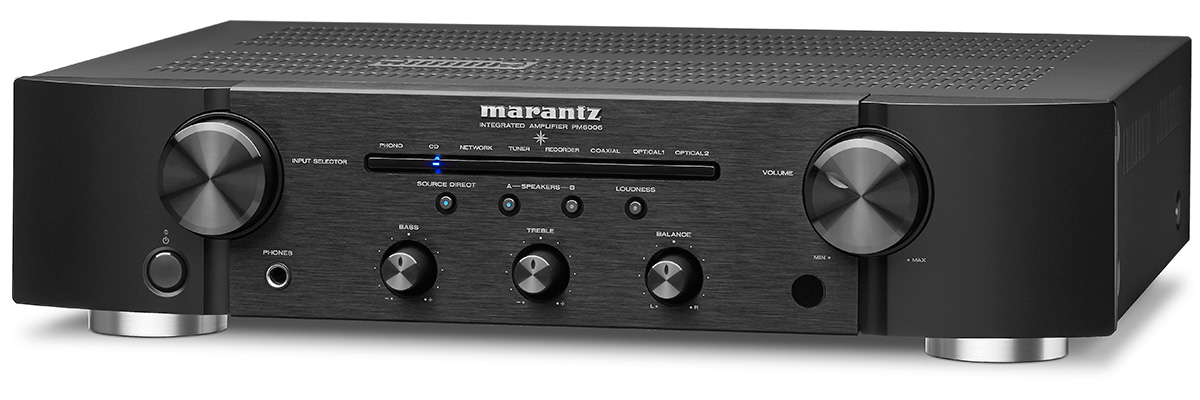
Marantz PM6006 replaced the Marantz PM6005 integrated amplifier. The main difference is the additional optical input and assembly are now made in Vietnam.
The Marantz PM6006 integrated stereo amplifier is available in an updated design that matches the concept of the Reference Design series. In addition to this modernization, a power supply unit was installed in which a new low-impedance toroidal transformer is installed, enclosed in an additional casing to reduce the level of external electrical noise. In addition, the Marantz PM6006 has new filter capacitors with higher temperature stability and lower noise levels. The power supply rectifier uses high-speed Schottky diodes. The output transistors in the amplifier are also replaced by ones with higher speed and the maximum allowable working current — refined and cooling radiators for these transistors.
Now you can connect various digital sources to it and use it as a high-quality, fully shielded DAC. It is implemented on the CS4398 chip (24 bit / 192 kHz), which has proven itself in the Premium Series models. The device has a metal front panel and is made on an anti-resonant chassis, which reliably protects electronic circuits from external influences. The power of the amp is 40W per channel at 8 ohms. 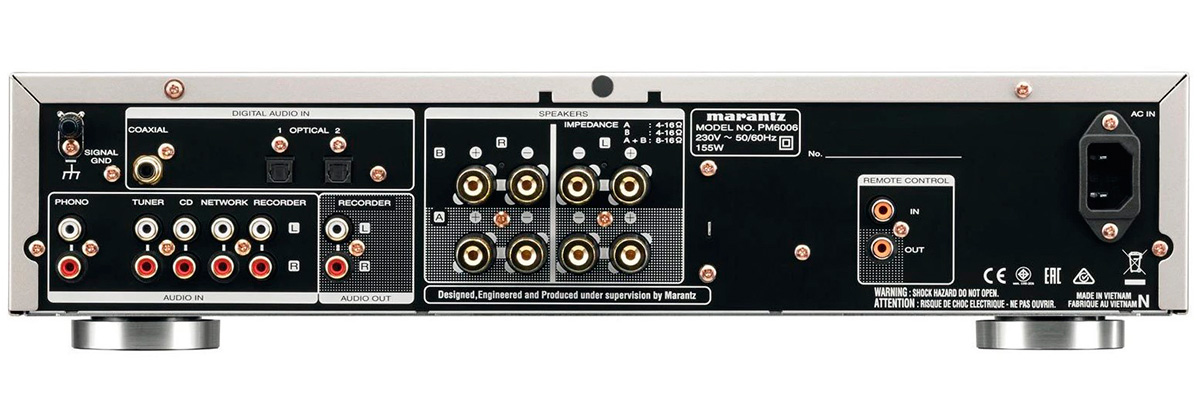
As a result, the company's engineers managed to significantly expand the dynamic and frequency ranges of this very successful device, making its sound even more attractive to music lovers. At the same time, the functionality of the Marantz PM6006 remained the same - it has a high-quality built-in phono stage for an MM pickup, five line inputs, and outputs for connecting two recording devices.
All line inputs are equipped with buffer circuits to reduce the effect of connecting cables on sound quality. On the front panel of the amplifier, there are controls for all modes of its operation, including adjusting the timbre in the field of low and high frequencies and stereo balance, as well as turning on the direct signal supply mode bypassing auxiliary circuits. The Marantz PM6006 features a switchable loudness circuit to improve the sound quality of your audio system when listening at low volume.
Key specs
- Power output (RMS), W/Ohm: 90/8, 120/4
- Line level inputs (pair): 5
- Phono (MM) input: yes
- Subwoofer output: no
- Official website
- Full specs
Pros
- Marantz has a fundamental understanding of what looks good, especially when you stack a PM6006 on it and make your other friends jealous
- iDevice Management
Cons
- I've had issues with volume control because the remote is too sensitive and makes it difficult to fine-tune the volume
Integrated amplifiers under 2000
Given that we passed the first two “cheap” categories here we have a good combination of price/quality with a bias in quality. Buying the amplifier from this section, you spend more money, but you get the device for a long time.
Marantz PM8006 - best under 2000
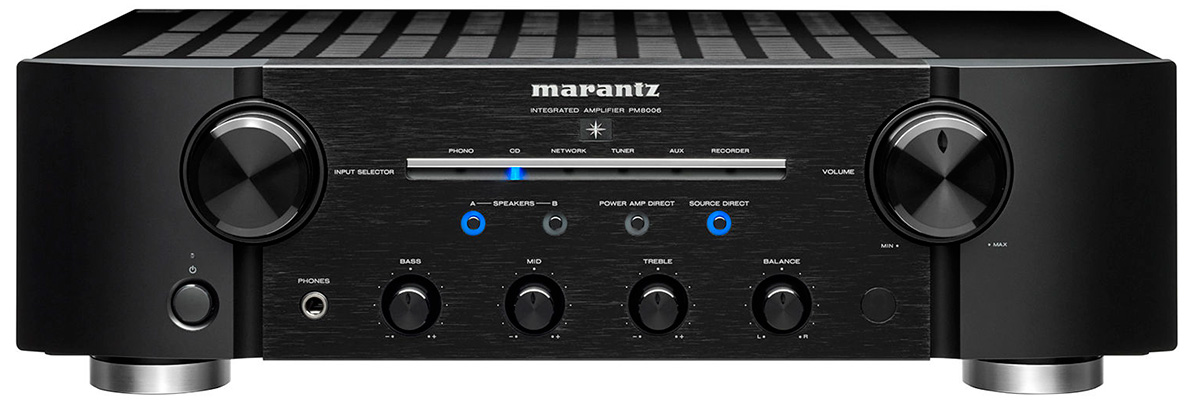
The stereo amplifier is made according to the classical scheme, without unnecessary newfangled lotions, which are now often stuffed with similar devices. The operation of the Marantz PM8006 is focused on the basic principles of amplifying incoming analog signals, and at a known, high level. This should especially appeal to lovers of vinyl.
In the center are the branded HDAM (Hyper Dynamic Amplifier Module), which are used here in the S3 version. These are operational amplifiers with discrete components that are capable of delivering greater dynamics and fine detail saturation. These include a double-shielded toroidal transformer and the shortest signal paths for the perfect sound.
Technically, the PM8006 can provide 2x 70 watts into 8 ohms, which provides enough power even for demanding speakers. With six RCA inputs, including a Phono MM module for players, the stereo amplifier provides ample connectivity for external analog and digital players.
In addition, through the preamplifier, you can directly connect the PreAmp sections to an external power amplifier or to active speakers. Like, for example, KEF LS50 Wireless. Also, the Marantz PM8006 gives us direct access to integrated power amplifiers, for example, to use the amplifier in a multi-channel system for two additional channels, such as Dolby Atmos. While listing all these points, I summed up that this is the best integrated amplifier under 2000. However, this is not all for now. Let’s continue. 
The manufacturer is especially proud of the built-in MM phono. During the process, according to this connection scheme, HDAM modules collide with JFET transistors, which lead to an increase in impedance and must ensure the elimination of connecting capacitors. Since the signal is amplified using a Class A operational amplifier, each component must be carefully thought out and optimized for a clean signal path. The front panel of the Marantz PM8006 is equipped with a convenient headphone output and three convenient tone controls for fine-tuning the low, mid, and high frequencies. Behind the analog volume control is a microprocessor for electronic adjustment. If you like to switch between two pairs of speakers, you have the option of using two pairs of connectors with A / B switching.
In my opinion, the sound of PM8006 is well balanced, laid-back, and rhythmically agile. He plays, on the one hand, with great detail and precise calibration of the instrument, on the other, with a deep bass base.
Marantz’s PM8006 will surely take its rightful place in the modern world of digitized audio, and its clear sound is suitable for any music genre, and the appearance and work will be impeccable, but anyone who appreciates a musical evening with vinyl will be happy with the Marantz PM 8006.
Key specs
- Power output (RMS), W/Ohm: 140/8, 200/4
- Line level inputs (pair): 7
- Phono (MM) input: yes
- Subwoofer output: no
- Official website
- Full specs
Pros
- It retains some of Marantz's signature homeliness, but to a lesser extent than previous amplifiers.
- The choice of input is huge, which allows you to connect almost everything imaginable
- Very high-quality input selector with distinctive latches as well as relay clicks when changing input
Cons
- Not enough dynamics and bass control
Peachtree Audio nova300
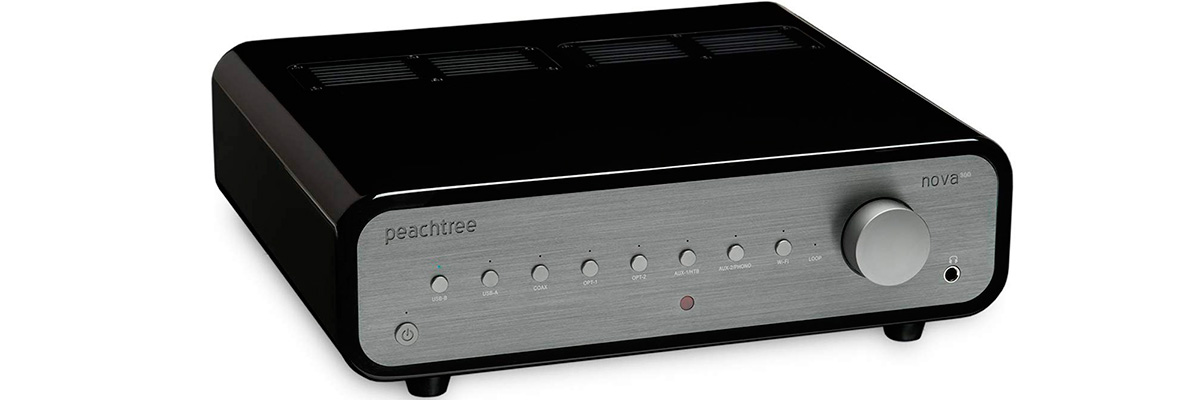
Nova300, at first glance, redefines what we consider quality. Thanks to glossy plywood or black piano plywood, the market is no longer similar to the Nova300. When they were put before friends and strangers, many people (of all genders) noted how great the Nova300 looks compared to other amplifiers and receivers in popular memory. Given several integrated amplifier reviews in some aspects, the Nova300 is an alternative timeline in aesthetics where the McIntosh wooden chassis remained the norm for high-tech electronics. Peachtree manages to rethink the vintage look and welcome modern tastes.
The DAC included in all Nova300s is a rebuilt ES9018K2M SABER32 chip that decodes everything from 32-bit / 384 kHz sound to 5.6DSD. Peachtree tube buffers are a thing of the past and with them a higher level of distortion. The new Peachtree Nova300 is a highly focused and detailed electronics sample with surprisingly low noise levels thanks to an unusually high 440K sampling rate and a final component signal-to-noise ratio of 111 dB. 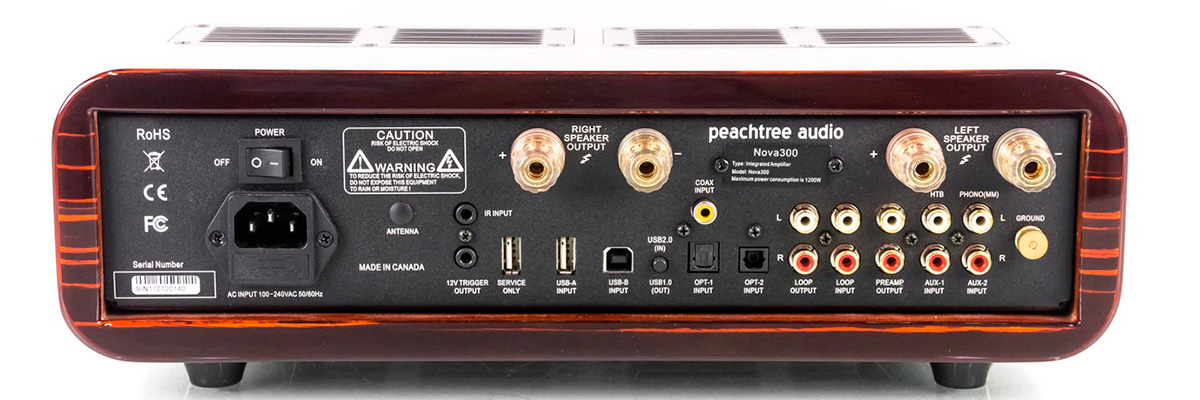
The source inputs are many — two USB, of which one is solely dedicated to syncing with Apple products intelligently. From there, one digital coaxial cable, and then two digital optical inputs. On the analog side are the processor circuit and one RCA kit, which are simultaneously used for both auxiliary and home theaters. A moving magnet phono-stage with the ground is included, which may also double as a second RCA line-level input when switched to that mode via its dedicated front fascia input selector. Furthermore, there is a WiFi input feature that should excite those who take a more tech-heavy approach to music listening.
The features, power, and connectivity make the Peachtree Nova300 inaccessible to many competitors at a price that is higher. Nobody offers what the Nova300 does for the price. No one does it so efficiently. It is very difficult not to recommend the Peachtree Nova300 to everyone, without exception, based only on technical specifications and price. With its impressive 300W per channel (8 Ohms), this vintage integrated amplifier is a real pleasure to deal with.
Key specs
- Power output (RMS), W/Ohm: 600/8, 900/4
- Line level inputs (pair): 3
- Phono (MM) input: yes
- Subwoofer output: no
- Official website
- Full specs
Pros
- Every feature you could want on an integrated amp
- Mind-blowing sound with practically unlimited power
Cons
- Initially had an issue of the amp shutting down randomly
- Front panel buttons are a little “squishy”
Integrated amplifier under 3000
Consumers of such units consider the priority in quality without compromise. These amplifiers are decent and are a real piece of art.
Yamaha A-S1100
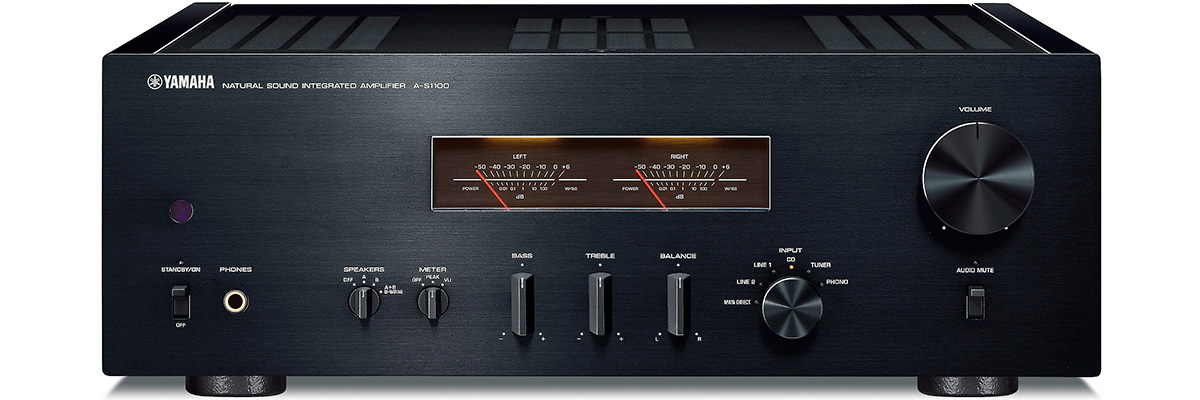
The Japanese manufacturer has released the integrated amplifier under 3000 - Yamaha A-S1100. In addition to the design inherited from the A-S2100 with an arrow level indicator on the front panel, it has new volume control and a Yamaha Floating amplification system with a symmetrical amplification circuit, the output stages of which are made on field-effect transistors.
Just like the A-S2000 amplifier, which was replaced in June 2014 by the A-S2100 after many years of reliable service, today, the A-S1000 gives way to the shelves of the Yamaha A-S1100 model.
Like the A-S3000 and A-S2100, the design is transformed with the appearance of a level gauge on the front panel. A reinforced chassis prevents vibrations, the sides have a wood finish, on the front aluminum panel we find a speaker selector, input selector, tone and balance controls, 6.35 mm output jack. In addition to the updated visual design, the A-S1100 also features a number of new features.
The completely symmetric amplifier circuit includes a powerful power transformer with four large capacitors in the power source. At the output stages, powerful MOS transistors are used. All of this is based on Yamaha Floating technology. A balanced gain circuit separates signal circuits from the chassis to avoid signal distortion caused by voltage fluctuations. 
The A-S1100 uses an original transformer with an EI core, carefully crafted for optimum chassis compatibility. The combination of four high-capacity carbon-clad block capacitors provides vibrant sound even at high volume, achievable only with the A-S1100.
Also, a new volume control circuit from New Japan Radio is integrated. The A-S1100 amplifier has an excellent power reserve of 2 x 90 W (nominal) for a load of 8 Ohms and up to 2 x 150 W for 4 Ohms, with a damping factor of 250 (8 Ohms, 1 kHz). Finally, there is a separate amplification scheme for the vinyl pickup. The headphone amplifier remains the prerogative of the A-S2100 and A-S3000. On the rear panel of the A-S1100 are four pairs of gold-plated screw terminals, three analog RCA inputs, an input for a MM / MC pickup, a line input, recording input/output, two pre-outs for connecting a subwoofer, they can be used together with a second amplifier for a pair of front speakers or a headphone output.
Key specs
- Power output (RMS), W/Ohm: 180/8, 300/4
- Line level inputs (pair): 7
- Phono (MM) input: yes
- Subwoofer output: no
- Official website
- Full specs
Pros
- You will not mix up channels. The connectors are clearly separated by a central array of inputs
- Flipping the lid, you will find pedantry in the placement of components
Cons
- When suddenly you need to raise the "middle", then here you will encounter the lack of such an opportunity
Tube integrated amplifier
This section concerns amplifiers whose circuitry is based on the use of radio tubes as amplifying elements. The nature of the distortions introduced by lamp circuits into the signal is significantly less noticeable to human hearing.
YAQIN MC-13S
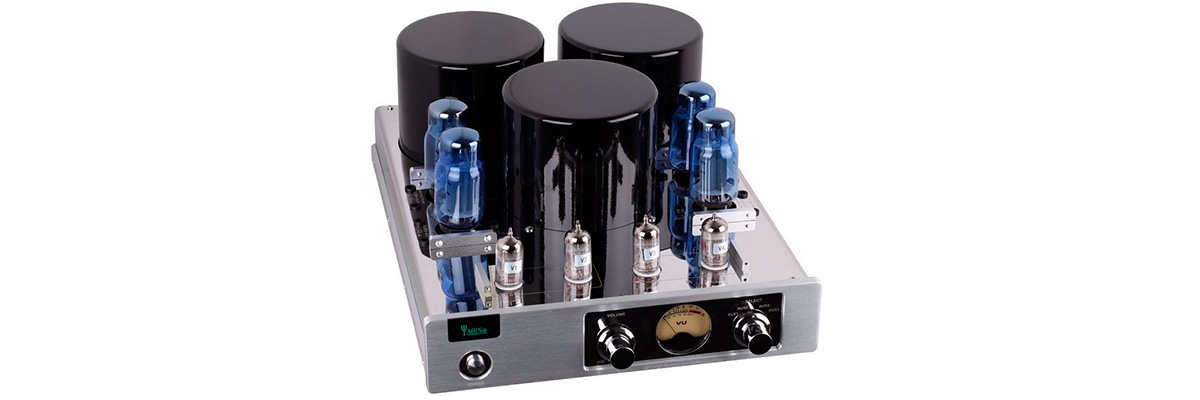
The MC-13S can be one of the main components of your home audio system. It gives the great sound clarity, without drawing attention to itself and without adding a hint of artificiality. The tone and clarity of the signal allow you to distinguish between individual instruments in any song that you are listening to. When there is silence, you do not have such a low-frequency hiss that you can usually associate with a tube amplifier. This is the best integrated tube amp. It is clearly well-engineered, and a lot of thought and care went into the design and architecture of this piece to maximize the amount of performance you can get out of your system. It delivers 40W at 8-ohm load. 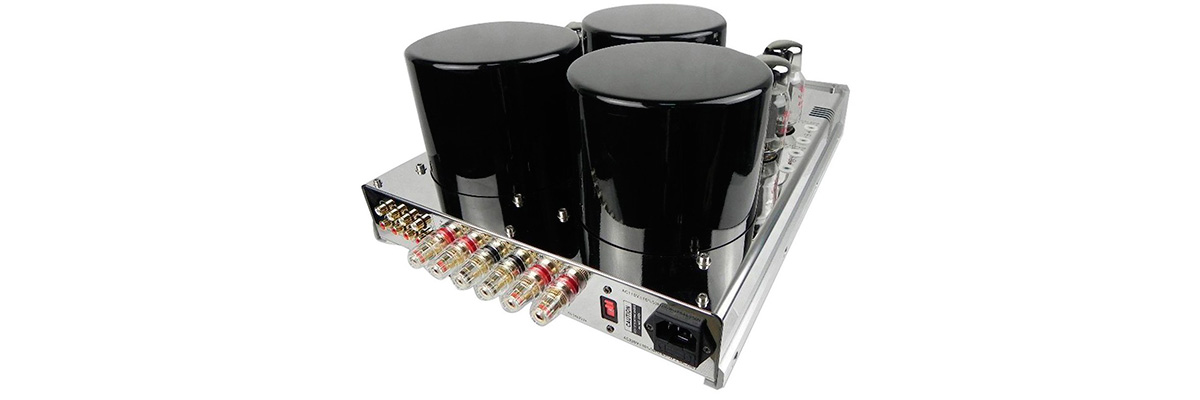
Many of the circuit components are of audiophile-grade, produced by famous Japanese, American, and European companies. Their circuits use Solen, Philips, Siemens, and
Thomson capacitors. Volume control from ALPS, a well-known Japanese company, is also used. Yaqin vacuum tubes are used by well-known Chinese manufacturers such as Shuguang. Yacin factory received a 3C certificate and a European CE certificate.
Overall, this amp can’t be considered “cheap,” although it is inexpensive compared to some of its competitors in terms of wattage, tone, and sheer style, such as the brushed-metal face. The Yaqin MC-13S has a deserved reputation and a cult following for delivering more bang for your buck. If you’re looking for the best integrated amplifier featuring tubes, look no further!
Key specs
- Power output (RMS), W/Ohm: 80/8, 110/4
- Line level inputs (pair): 4
- Phono (MM) input: no
- Subwoofer output: no
- Full specs
Pros
- The sound is very quality-oriented. An amp is not supposed to color the sound nor is it supposed to sound "loud"
- The VU meter on the front does indeed work "real-time"
Cons
- A headphone jack and possibly even tone controls would be nice. So would a subwoofer out
Buying guide
Integrated amplifier vs AV receiver
Besides the fact that the receiver can receive radio signals, an integrated amp is invariably a preamp and two-channel amplifier. The receiver can be stereo (2 channels) or surround (5.1 / 7.1 / 9.1 / 11.4, etc.), and, more specifically, the definition of the receiver includes a radio tuner.
At the same time, if you're chasing a premo two-channel setup, you will get a better soundstage presentation and SQ from an integrated two-channel over a receiver, depending on the choice of product.
To sum up, the integrated amplifier is a preamplifier and a power amplifier in a single package. It can be any number of channels, just as a receiver can be any number of channels. The receiver is a tuner, preamplifier, and power amplifier in one housing.
There are also several tuner/preamp combinations. They go without power amplifiers.
As for the quality of each, it completely depends on what the manufacturer decides to put in the cabinet. Anyone can be good or bad.
Amplifier vs preamplifier
The preamplifier acts like a switch - it can take one or more signal sources and route that source to an amplifier.
Amplifiers like to see signals in the range of 0–2 V RMS and usually apply a gain of 26 dB to the signal. They have the ability to control the complex loads of speakers with high voltage and current. Amplifier inputs usually have high impedance, and outputs have low impedance. Entrances love to see that it is easy to manage medium and high loads.
So the preamplifier takes whatever source it gets, and prepares that signal with a medium to high output impedance and current for the amplifier to drive speakers. The amplifier is a good place to do signal manipulation.
-
 #1
#1Yamaha A-S801
- Yamaha
- | 1000
- 378
-
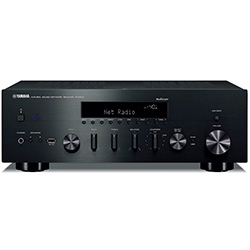 #2
#2Yamaha R-N602
- Yamaha
- | 700
- 49
-
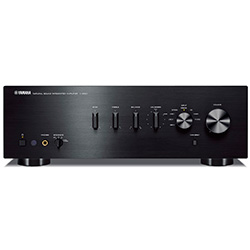 #3
#3Yamaha A-S501
- Yamaha
- | 600
- 378
-
 #4
#4Marantz PM6007
- Marantz
- | 700
-
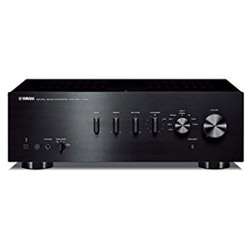 #5
#5Yamaha A-S301
- Yamaha
- | 400
- 378
-
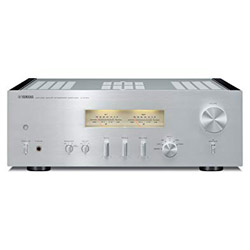 #6
#6Yamaha A-S1100
- Yamaha
- | 2500
- 11
-
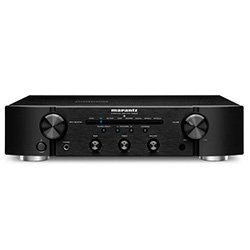 #7
#7Marantz PM8006
- Marantz
- | 1200
- 30
-
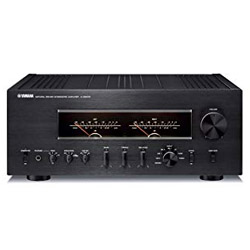 #8
#8Yamaha A-S3000
- Yamaha
- | 7000
- 36
-
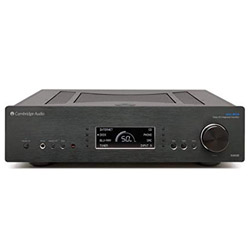 #9
#9Cambridge Audio Azur 851A
- Cambridge Audio
- | 1500
- 16
-
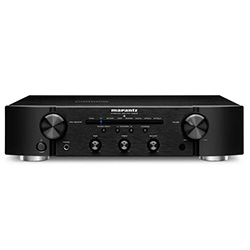 #10
#10Marantz PM6006
- Marantz
- | 700
- 246
-
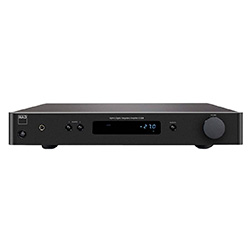 #11
#11NAD C338
- NAD
- | 700
- 12
-
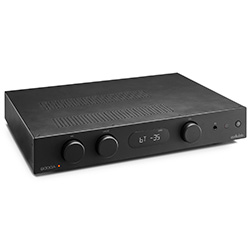 #12
#12Audiolab 6000A
- Audiolab
- | 1000
- 3
-
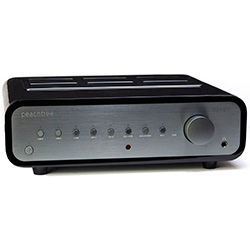 #13
#13Peachtree Audio nova150
- Peachtree Audio
- | 1400
- 7
-
 #14
#14NAD D 3020 V2
- NAD
- | 500
- 113
-
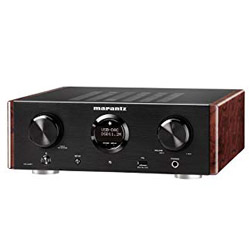 #15
#15Marantz HD-AMP1
- Marantz
- | 800
- 34
-
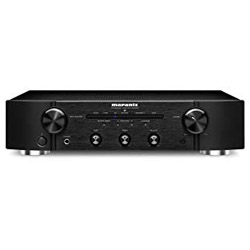 #16
#16Marantz PM5005
- Marantz
- | 500
- 47
Recent reviews

